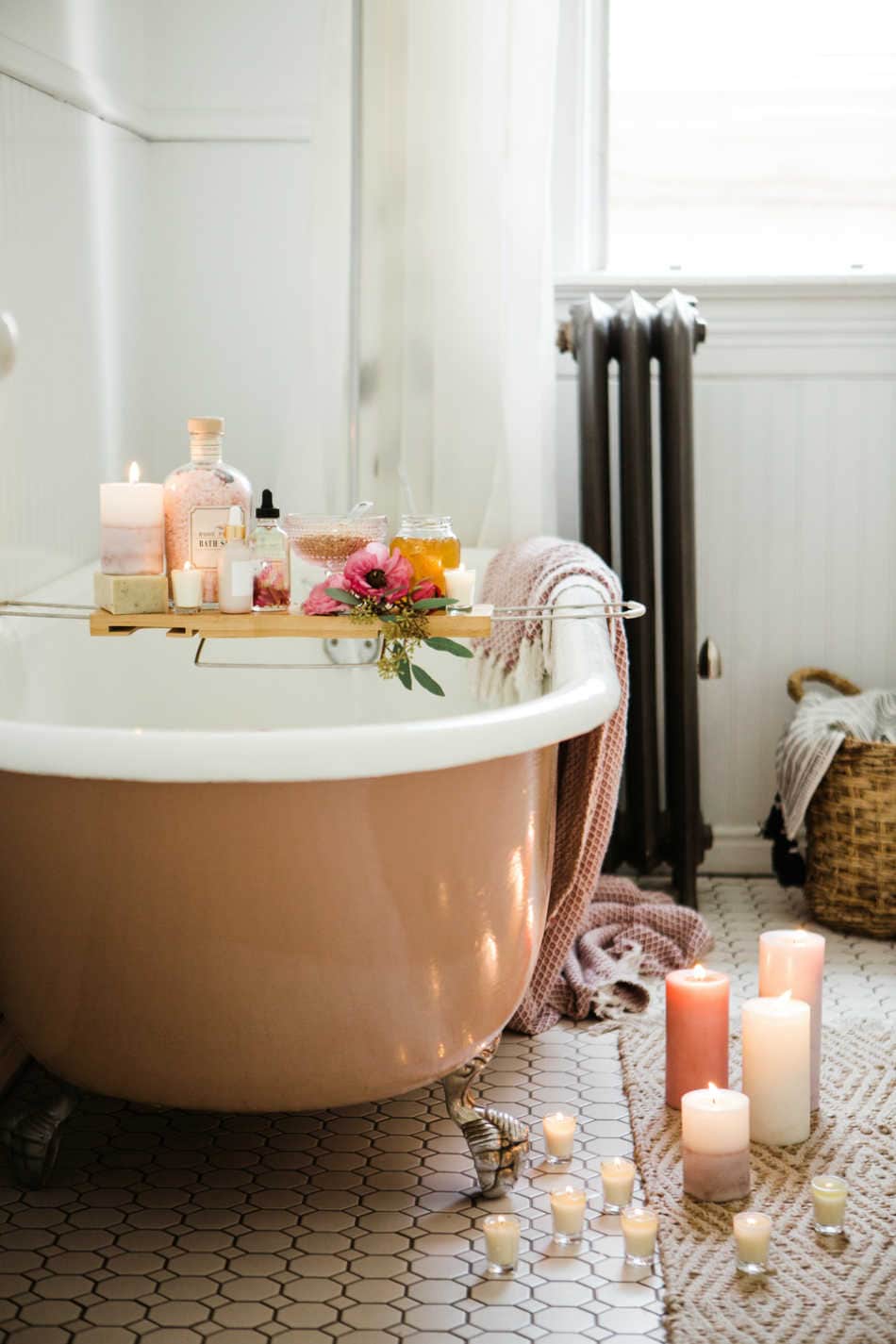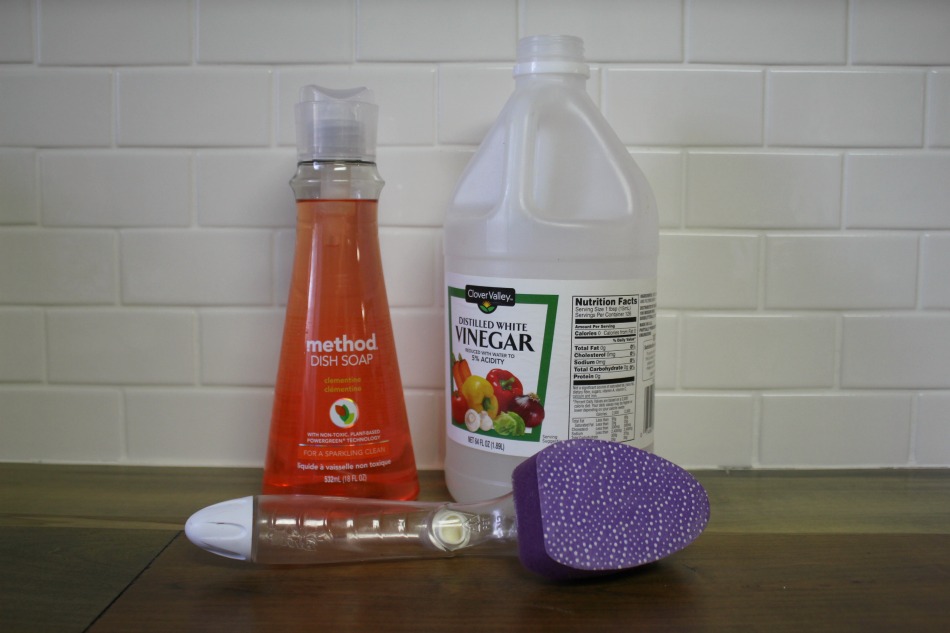
My kids love taking baths, and so do I.
Since our family spends a decent amount of time in the tub, I knew I needed to find some sort of natural cleaner that would do the job quickly while getting everything clean and shiny and not leaving any sort of harmful residues or toxins behind.
I excitedly stumbled across this recipe somewhere on Pinterest, and I LOVE it. It does everything I need, and today I want to share it with you! Check it out.
Natural Cleaner For The Bathtub & Shower

You’ll Need:
- Scotch-Brite Dishwand with non-scratch sponges
- white vinegar
- dishwashing soap (not pure Castille soap) (I like this brand or this one)
Directions:
- Open your cleaning wand and fill it half full of your soap.
- Top the last half off with white vinegar.
- Shake well to mix your soap and vinegar.
To Use:
Wet your tub or shower and rub with your wand until clean. Rinse with water.

Did You Know…
Did you know that chemical cleaners leave a residue behind after you clean with them? It’s true, they do. It’s a powder-like film that wipes off when you touch it… even when your kid touches it. This residue actually consists of the chemicals that you used to clean your house with, and now those chemicals are on your child.
You wouldn’t clean your child with these chemicals, would you? Of course not! Chemicals are toxic to the body, and in many cases, they can cause health problems for you and your children. I’m talking about small things that you wouldn’t even attribute to toxin buildup in the body.
That’s why I think it’s important to go as natural as possible in as many areas of our lives as we can.
I know you’re busy. So am I. So that’s why I decided to start with something that wasn’t too time-consuming, wasn’t going to cost me a ton of money, and would give me the most bang for my buck. Natural cleaners!
If you liked this post… share it on Facebook and Twitter or pin it to Pinterest!
Love and light,
Meagan
I love this! Putting the cleaner in the wand is such a great idea! Will definitely be doing this.
Thanks!
I LOVE this recipe! It works so well and it’s easy! Thanks for your comment Stacy!
Can you clarify what soap you’d use?
Sure patty… I use the soap I make and sell in my Etsy shop… but that may not be very cost effective for most. A little soap goes a long way so you won’t use much. The reason I use it is because I know it’s good, healthy soap and because it’s the soap my family and I use.
If I didn’t have it, I may use a cheap soap from the store. One that is NOT antibacterial. Just some cheap, basic soap. That’s really all you need… something that will mix with the vinegar to cut the soap scum on the tub. I love this recipe… it’s my absolute favorite way to clean my tub and shower. It’s so easy and it works!
Hope this answers your question Patty! Thanks for your comment!
Megan, I make my own cold-pressed bar soap. Is this what you are using or are you using homemade liquid soap?
I actually used to use homemade liquid soap, but I haven’t made any of it in a while so I’m not using Seventh Generation liquid soap. I’d love to find time to make homemade liquid soap again though. It worked so well for so many different things!
I clean houses for a living and use a soap vinegar combo as well on the showers. I would not recommend ever using a scrub wand however on a fiberglass shower. This will cause scratching that will make the shower accumulate hard water and soap scum film much faster.
Also, despite all of the recipes you see adding vinegar to a castile or all natural based soap this is a bad idea! When combined there is a chemical reaction that unsaponifies the soap negating the benefits of both the vinegar and soap. Lisa Bronner, of Dr. Bronner’s soaps discusses this here, http://lisa.drbronner.com/?p=292.
Instead I use a detergent, which reacts differently than the traditional soap. The other option is to clean with the soap, and then use the vinegar as a rinse.
Also, vinegar at this strength can cause spotting on metal faucets.
Thanks for your comment Jamie. My tub is a fiberglass tub, and at this point I’ve not had any problems using this cleaning wand. Now who knows years down the road, but I’m curious if this same thing can occur from using chemical cleaners. Does it eat away at the tubs finish? I don’t scrub my tub hard… it doesn’t really take much to get it off. Anyway, it is something to consider. If I had a brand new tub that cost a lot of money, I may think twice about using the cleaning wand.
As far as mixing the soap and vinegar… the article makes sense about soap being a base and vinegar being an acid, but I’ve never had my soap look like that in the picture, and the way I show to mix it in the video (50/50) works perfectly every time… taking dirt and soap scum off easily. Like I said, I’ve never had to scrub my tub.
What kind of detergent are you using. I think for most of us looking to make our own homemade cleaning products, saving money is a huge factor, but more than that… doing it naturally plays a bigger role. Most detergents aren’t natural which is why I personally use soap, but I am curious about what you use.
Also, I totally agree about not using vinegar on metal. There are better things to clean metals with! Thanks again for your comment. I love hearing other people’s viewpoints!
I use Dawn dish soap simply because I have to clean a lot of tubs every week and it’s cheaper. I know that some laundry detergents are made with coconut based surfactants and I’m assuming this would work, although I haven’t tried it.
When you mix the vinegar and the soap they can create a milky appearance but as far as I know the same reaction occurs. Maybe this depends on how the castile soap is made, I’m not sure. Even if the mixture is milky, if it feels oily on your hand and doesn’t suds then it’s been unsaponified. Lisa discusses this in a response further down the article.
Fiberglass showers are sold with a protective coating on them that can scratch with harsher cleaners and the scotch brite type scrubbies. Once this coating gets old and scratched though it’s gone. So if you’re using it in an older shower that’s already scratched up it won’t make much of a difference. I’ve used the scrubbies on the floor of the tub, just not on the walls of a fiberglass shower.
I asked someone who manufactures and sells fiberglass showers in my area how best to clean them and they said vinegar. So it really is the best thing for it! At home I can afford to use more expensive cleaners and I favor cleaning with the natural soap and then rinsing with vinegar.
Thank you for all of your wonderful posts and everything you do. I enjoy reading your blog so much! Sorry if I sounded grumpy, I really didn’t intend to! I’ve probably cleaned hundreds of tubs and showers and I’ve had the chance to try many different techniques and cleaners so I was simply trying to relate my experiences in cleaning.
Thanks again for all the work you put into this, it’s very much appreciated!
Oh no!! I didn’t think you were being grumpy… just sharing your expertise with me, and I so appreciate that! I hope I come across not as someone with all the answers, but as someone who is continually growing and learning. I feel like my answers to things are constantly changing and expanding. This is one of those things.
I had no idea that castile soap would get thrown out of suspension with vinegar. It makes total sense when you look at the acid-base aspect.
The first time I used this recipe I used Dawn soap and it worked great. Every other time I’ve used my baby soap I sell in my shop… which isn’t a pure 100% castile soap… it has coconut oil and other goodies in it. Since it’s already milky looking I can tell if the soap is unsaponifying from appearance only, but it doesn’t get curdy looking and it doesn’t feel greasy so I don’t think it is. This is something to keep in mind though.
As far as fiberglass goes… that’s tough. Maybe I don’t clean my shower enough to notice a difference! LOL! Anyway. what do you clean the walls of fiberglass showers with if not anything abrasive? I just liked the scrubbing wand because it saved me a lot of elbow grease!
Well I’m glad I didn’t sound too grumpy lol. I use a double sided scrubbie sponge, so it has the green scotch brite cleaner on one end and the soft sponge on the other. I use the green side for the floor and the sponge for the walls and sides.
If you let the vinegar mix set for a bit before you wash it off this does a lot of the work for you. Just don’t let it dry though because then you just have a mess! I usually spray it on then clean the toilet and sink before coming back to the shower.
The vinegar helps to dissolve the hard minerals on the walls and the soap ironically removes the soap scum. I make mine with 1 part soap, 2 parts vinegar and 2 parts water. This way I can really soak the walls and come back to it before it has a chance to dry. I’ll fill a cup with warm water and dip the sponge in it as I scrub the walls to get it really wet and soapy.
I’ve had problems with Dr. Bronner’s castile soap and Dessert Essence soap mixing with vinegar so I use Shaklee brand Basic H soap and Dawn in my cleaning products.
Also, I haven’t used it because it’s a chemical, but you can by gel gloss coat to restore the finish on the fiberglass.
Humm… well thanks for the tips. If I ever run into any trouble with the coating… I’ll keep the gel gloss stuff in mind. Thank you!
Dr. Bronner’s has a detergent called Sal Suds. This is what they recommend on their website to mix with vinegar recipes instead of their regular castile soap.
Thanks for the tips and recipes!!!
I am so glad I found your site. I really found you by accident, while I was browsing on Bing for something else. Anyways I am here now and would just like to say thank you for a useful post and an all round enjoyable blog. (I also love the theme/design), I don’t have time to read through it all at the minute, but I have added your website to my favorites, so when I have time I will be back to read more. Please do keep up the awesome job!
Welcome Leone, and thank you for your kind comments! I hope you find lots of valuable information here!
[…] – DIY Tub & Shower Cleaner – Growing Up […]
5
3.5